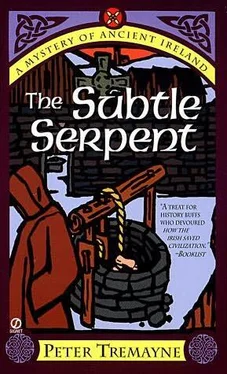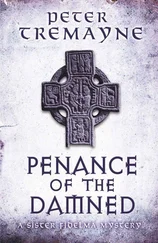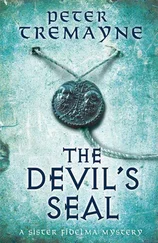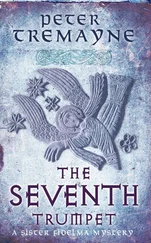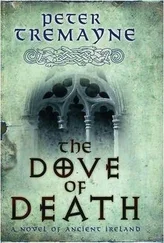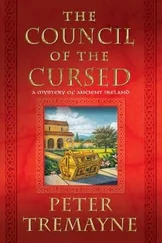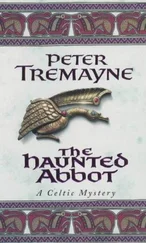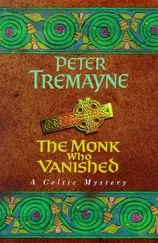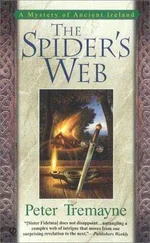Peter Tremayne - The Subtle Serpent
Здесь есть возможность читать онлайн «Peter Tremayne - The Subtle Serpent» весь текст электронной книги совершенно бесплатно (целиком полную версию без сокращений). В некоторых случаях можно слушать аудио, скачать через торрент в формате fb2 и присутствует краткое содержание. Жанр: Исторический детектив, на английском языке. Описание произведения, (предисловие) а так же отзывы посетителей доступны на портале библиотеки ЛибКат.
- Название:The Subtle Serpent
- Автор:
- Жанр:
- Год:неизвестен
- ISBN:нет данных
- Рейтинг книги:3 / 5. Голосов: 1
-
Избранное:Добавить в избранное
- Отзывы:
-
Ваша оценка:
- 60
- 1
- 2
- 3
- 4
- 5
The Subtle Serpent: краткое содержание, описание и аннотация
Предлагаем к чтению аннотацию, описание, краткое содержание или предисловие (зависит от того, что написал сам автор книги «The Subtle Serpent»). Если вы не нашли необходимую информацию о книге — напишите в комментариях, мы постараемся отыскать её.
The Subtle Serpent — читать онлайн бесплатно полную книгу (весь текст) целиком
Ниже представлен текст книги, разбитый по страницам. Система сохранения места последней прочитанной страницы, позволяет с удобством читать онлайн бесплатно книгу «The Subtle Serpent», без необходимости каждый раз заново искать на чём Вы остановились. Поставьте закладку, и сможете в любой момент перейти на страницу, на которой закончили чтение.
Интервал:
Закладка:
‘No, I do not think so. There was no need to draw fresh water until midday.’
‘Go on.’
‘Well, we both hauled away at the mechanism until the corpse appeared.’
‘You were both shocked, of course?’
‘Of course. The thing was without a head. We were afraid.’
‘Did you notice anything else about the corpse?’
‘The crucifix? Yes. And, of course, the aspen wand.’
‘The aspen wand?’
‘Tied on the left forearm was a stick of aspen wood on which Ogham characters were cut.’
‘And what did you make of it?’
‘Make of it?’
‘What did the characters say? You clearly recognised what it was.’
Brónach shrugged eloquently.
‘Alas, I can recognise Ogham characters when I see them written, sister, but I have no knowledge of their meaning.’
‘Did Sister Síomha read it?’
Brónach shook her head and lifted the bronze vessel from the fire, removing the items of clothing with a stick and putting them into a tub of cold water.
‘So neither of you were able to read the Ogham or recognise its purpose?’
‘I told the abbess at the time that I thought it was some pagan symbol. Didn’t the old ones tie twigs on a corpse to protect against the vengeful souls of the dead?’
Fidelma stared carefully at the middle-aged sister but she had her back turned as she bent to her task beating the clothes to take the water out of them.
‘I have not heard that, Sister Brónach. What was the abbess’s response to your idea?’
‘Abbess Draigen keeps her own counsel.’
Was there an angry tone to her voice?
Fidelma rose from the tub and reached for the drying cloth before scrambling out. She rubbed herself energetically, rejoicing in the invigoration of her limbs. She felt fresh and relaxed as she put on her clean clothing. Since her return from Rome she had indulged herself by using undershirts of white sída or silk, which she had brought back with her. She noticed Sister Brónach casting a look at the garments, an almost envious look which was the first emotion Fidelma had witnessed on her generally mournful countenance. On top of her underwear, Fidelma drew on her brown inar or tunic which came down nearly to her feet and was tied with atasselled cord at her waist. She slipped her feet into her well-shaped, narrow-toed leather shoes, cuaran, which were seamed down along the instep and were fitted without the necessity of thongs to fasten them.
She turned to the mirror and completed her toilet by setting her long, rebellious red hair in place.
She was aware that Sister Brónach had fallen silent now, as she finished laundering Fidelma’s dirty clothes.
Fidelma rewarded her with a smile.
‘There now, sister. I feel human again.’
Sister Brónach was contented to nod without any comment.
‘Is there anything else to tell me?’ Fidelma pressed. ‘For example, what happened after you and Sister Síomha pulled the body from the well?’
Sister Brónach kept her head lowered.
‘We said a prayer for the dead and then I went to fetch the abbess while Sister Síomha stayed with the body.’
‘And you returned directly with Abbess Draigen?’
‘As soon as I had found her.’
‘And the Abbess Draigen took charge?’
‘Surely so.’
Fidelma picked up her bag, turning for the door but then pausing a moment by it to glance back.
‘I am grateful to you, Sister Brónach. You keep your guests’ hostel well.’
Sister Brónach did not raise her eyes.
‘It is my duty,’ she said shortly.
‘Yet for duty to have meaning you must be content in its performance,’ Fidelma replied. ‘My mentor, the Brehon Morann of Tara, once said — when duty is but law then enjoyment ends for the greater duty is the duty of being happy. Good night, Sister Brónach.’
In the Abbess Draigen’s chamber, the abbess regarded the flushed-faced Fidelma — her flesh still tingling after thewarmth of her bath — with begrudging approval. The abbess was seated at her table on which a leather-bound Gospel was open at a page she had been contemplating.
‘Sit down, sister,’ she instructed. ‘Will you join me in a glass of mulled wine to keep out the evening chill?’
Fidelma hesitated only a moment.
‘Thank you, mother abbess,’ she said. As she had been conducted across the abbey courtyard by a young novice, who introduced herself as Sister Lerben, personal attendant to the abbess, she had felt a soft flurry of snow and knew that the evening would become more icy.
The abbess rose and went to a jug standing on a shelf. An iron bar was already heating in the fire and the abbess, wrapping a leather cloth around it, drew it out of the fire and plunged its red hot point in the jug. She then poured the warm liquid into two pottery goblets and handed one to Fidelma.
‘Now, sister,’ she said, as each had taken some appreciative sips at the liquid, ‘I have those objects which you wanted to see.’
She took something wrapped in cloth and placed it on the table, then sat opposite and began to sip her wine again while watching Fidelma above the rim.
Fidelma set down her goblet and unwrapped the cloth. It revealed a small copper crucifix and its leather thong.
She stared at the burnished object for a long time before she suddenly remembered her mulled wine and took a hurried sip at it.
‘Well, sister,’ asked the abbess, ‘and what do you make of it?’
‘Little of the crucifix,’ Fidelma replied. ‘It is common enough. Poor craftsmanship and the sort that many of the sisterhood have access to. It could well be of local craftsmanship. It is a crucifix that an average religieuse might possess. If this belonged to the girl whose body you found then it denotes that she was an anchoress.’
‘In that, I concur. Most of our community have similarly worked copper crucifixes. We have an abundance of copper in this area and local craftsmen produced many such as that. The girl does not appear to be local, though. A farmer from nearby thought it might have been his missing daughter. He came to see the body but that turned out not to be the case. His daughter had a scar which the body did not possess.’
Fidelma raised her head from contemplation of the crucifix.
‘Oh? When was this farmer come here?’
‘He came to the abbey on the day after we found the body. He was named Barr.’
‘How did he know the body had been found?’
‘News travels rapidly in this part of the world. Anyway, Barr spent a long time examining the body, he obviously wanted to make sure. The corpse may be that of a religieuse from some other district.’
Indeed, thought Fidelma, it would fit in with the condition of the corpse’s hands if she was a member of a religious house. The women who did not labour in the fields, indeed the men also, prided themselves on having well manicured hands. Fingernails were always kept carefully cut and rounded and it was considered shameful for either men or women to have unkempt nails. One of the great terms of abuse was to call someone créhtingnech or ‘ragged nails’.
Yet it did not fit with the coarsely-kept feet, the mark of an ankle manacle, and the signs of scourging on the girl’s back.
The abbess had picked up another piece of cloth and laid it carefully on the table.
‘This is the aspen wand which was found tied on the left forearm,’ she announced, carefully throwing back the cloth.
Fidelma was gazing at a wand of aspen some eighteen inches in length. The first thing that she noticed was that it was notched in regular measurements and then, to one side,was a line of Ogham, the ancient Irish form of writing. The characters were more newly cut than the measurements on the other side of the stick. She looked closely at them, her lips forming the words.
Читать дальшеИнтервал:
Закладка:
Похожие книги на «The Subtle Serpent»
Представляем Вашему вниманию похожие книги на «The Subtle Serpent» списком для выбора. Мы отобрали схожую по названию и смыслу литературу в надежде предоставить читателям больше вариантов отыскать новые, интересные, ещё непрочитанные произведения.
Обсуждение, отзывы о книге «The Subtle Serpent» и просто собственные мнения читателей. Оставьте ваши комментарии, напишите, что Вы думаете о произведении, его смысле или главных героях. Укажите что конкретно понравилось, а что нет, и почему Вы так считаете.
